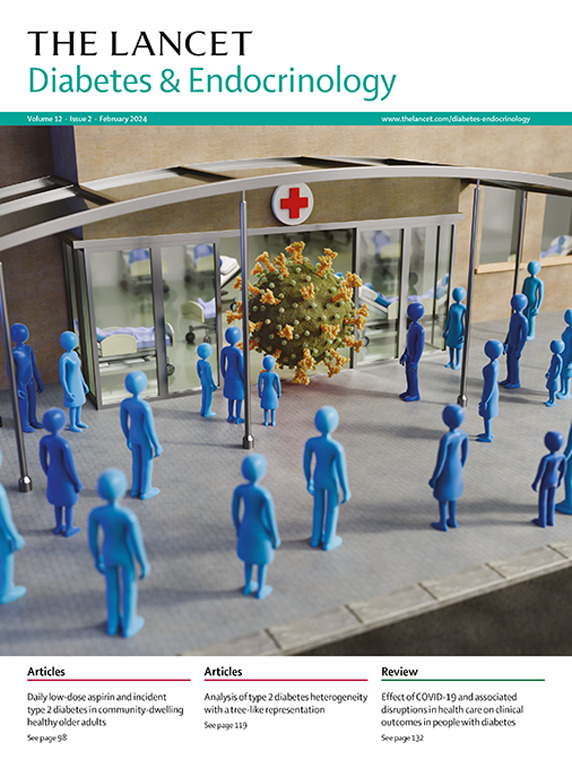Efficacy and safety of monlunabant in adults with obesity and metabolic syndrome: a double-blind, randomised, placebo-controlled, phase 2a trial
IF 41.8
1区 医学
Q1 ENDOCRINOLOGY & METABOLISM
引用次数: 0
Abstract
Background
Monlunabant, a novel cannabinoid receptor 1 (CB1R) inverse agonist, has shown encouraging weight loss efficacy and tolerability. We aimed to evaluate the efficacy and safety of monlunabant in individuals with obesity and metabolic syndrome.Methods
This 16-week, randomised, double-blind, placebo-controlled, dose-ranging phase 2a trial, conducted at 25 outpatient research centres in Canada, enrolled adults with obesity and metabolic syndrome. Participants were randomly assigned (1:1:1:1) by means of an interactive response system to once-daily oral tablets of monlunabant 10 mg, 20 mg, 50 mg, or placebo. The participants, site staff, sponsor, and contract research organisation were masked to treatment allocation. The primary endpoint was mean bodyweight (kg) change from baseline at week 16 versus placebo, assessed in all eligible randomised participants, whereas the safety analysis was done in all randomised participants who received at least one dose of trial product. The estimator for the primary estimand was analysed using a mixed model for repeated measures, assuming missing data are missing at random. This trial is registered with ClinicalTrials.gov (NCT05891834) and is complete.Findings
From Sept 8, 2023, to Jan 26, 2024, 409 individuals were screened for eligibility. In total, 243 individuals were randomly assigned to monlunabant 10 mg (n=61), monlunabant 20 mg (n=61), monlunabant 50 mg (n=60), and placebo (n=61); 242 participants received treatment, including 167 (69%) females and 75 (31%) males. 183 (76%) of 242 participants completed the trial: 50 (82%) of 61 received monlunabant 10 mg, 42 (70%) of 60 received monlunabant 20 mg, 34 (57%) of 60 received monlunabant 50 mg, and 57 (93%) of 61 received placebo. At week 16, participants receiving monlunabant showed statistically significant weight loss compared with those receiving placebo (least squares mean difference vs placebo of –6·4 kg [95% CI –8·0 to –4·9] for monlunabant 10 mg, –6·9 kg [–8·5 to –5·3] for monlunabant 20 mg, and –8·0 kg [–9·7 to –6·4] for monlunabant 50 mg). Adverse events were mostly mild to moderate gastrointestinal and psychiatric disorders and were seen in 42 (69%) of 61 participants in the monlunabant 10 mg group, 47 (78%) of 60 participants in the monlunabant 20 mg group, 55 (92%) of 60 participants in the monlunabant 50 mg group, and 42 (69%) of 61 participants in the placebo group. Withdrawals due to adverse events appeared dose-dependent, occurring in eight (13%) participants who received monlunabant 10 mg, 16 (27%) who received monlunabant 20 mg, 25 (42%) who received monlunabant 50 mg, and none who received placebo, driven by nausea, anxiety, diarrhoea, irritability, and sleep disorder. No deaths were reported.Interpretation
Participants receiving monlunabant showed statistically significant and clinically meaningful weight loss compared with those receiving placebo for all tested doses. Only slightly greater weight loss was observed at higher doses, whereas adverse events appeared dose dependent. Further investigation is needed to assess the safety and efficacy of lower doses of monlunabant, to evaluate its potential as a medication for obesity.Funding
Inversago Pharma (a Novo Nordisk company).monlunabant治疗成人肥胖和代谢综合征的疗效和安全性:一项双盲、随机、安慰剂对照的2a期试验
monlunabant是一种新型的大麻素受体1 (CB1R)逆激动剂,已显示出令人鼓舞的减肥功效和耐受性。我们的目的是评估monlunabant对肥胖和代谢综合征患者的疗效和安全性。这项为期16周的随机、双盲、安慰剂对照、剂量范围的2a期试验在加拿大的25个门诊研究中心进行,招募了患有肥胖和代谢综合征的成年人。参与者被随机分配(1:1:1:1:1),通过一个互动反应系统,每天一次口服monlunabant片10mg, 20mg, 50mg,或安慰剂。参与者、现场工作人员、赞助商和合同研究组织对治疗分配不知情。主要终点是在第16周与安慰剂相比的平均体重(kg)基线变化,在所有符合条件的随机受试者中进行评估,而在所有接受至少一剂试验产品的随机受试者中进行安全性分析。假设丢失的数据是随机丢失的,使用重复测量的混合模型分析初级估计的估计量。该试验已在ClinicalTrials.gov注册(NCT05891834),并已完成。从2023年9月8日到2024年1月26日,409人接受了资格筛选。总共有243名患者被随机分配到monlunabant 10 mg (n=61)、monlunabant 20 mg (n=61)、monlunabant 50 mg (n=60)和安慰剂组(n=61);242名参与者接受了治疗,其中167名(69%)女性和75名(31%)男性。242名受试者中有183名(76%)完成了试验:61名受试者中有50名(82%)接受monlunabant 10mg, 60名受试者中有42名(70%)接受monlunabant 20mg, 60名受试者中有34名(57%)接受monlunabant 50mg, 61名受试者中有57名(93%)接受安慰剂。在第16周,接受monlunabant的受试者与接受安慰剂的受试者相比,体重减轻具有统计学意义(monlunabant与安慰剂的最小二乘平均差值为:monlunabant 10 mg组为- 6.4 kg [95% CI为- 8.0至- 4.9],monlunabant 20 mg组为- 6.9 kg[- 8.5至- 5.3],monlunabant 50 mg组为- 8.0 kg[- 9.7至- 6.4])。不良事件主要是轻度至中度的胃肠道和精神疾病,在61名monlunabant 10mg组中有42名(69%)出现,在60名monlunabant 20mg组中有47名(78%)出现,在60名monlunabant 50mg组中有55名(92%)出现,在61名安慰剂组中有42名(69%)出现。不良事件引起的停药出现剂量依赖性,服用莫那班10mg的患者中有8人(13%)出现停药,服用莫那班20mg的患者中有16人(27%)出现停药,服用莫那班50mg的患者中有25人(42%)出现停药,而服用安慰剂的患者中没有出现停药,这些不良事件是由恶心、焦虑、腹泻、易怒和睡眠障碍引起的。没有死亡报告。与接受安慰剂的受试者相比,接受蒙那班的受试者在所有测试剂量下均表现出具有统计学意义和临床意义的体重减轻。在较高的剂量下,仅观察到轻微的体重减轻,而不良事件似乎与剂量有关。需要进一步的研究来评估低剂量monlunabant的安全性和有效性,以评估其作为肥胖药物的潜力。投资inversago Pharma (Novo Nordisk公司)。
本文章由计算机程序翻译,如有差异,请以英文原文为准。
求助全文
约1分钟内获得全文
求助全文
来源期刊

The Lancet Diabetes & Endocrinology
ENDOCRINOLOGY & METABOLISM-
CiteScore
61.50
自引率
1.60%
发文量
371
期刊介绍:
The Lancet Diabetes & Endocrinology, an independent journal with a global perspective and strong clinical focus, features original clinical research, expert reviews, news, and opinion pieces in each monthly issue. Covering topics like diabetes, obesity, nutrition, and more, the journal provides insights into clinical advances and practice-changing research worldwide. It welcomes original research advocating change or shedding light on clinical practice, as well as informative reviews on related topics, especially those with global health importance and relevance to low-income and middle-income countries. The journal publishes various content types, including Articles, Reviews, Comments, Correspondence, Health Policy, and Personal Views, along with Series and Commissions aiming to drive positive change in clinical practice and health policy in diabetes and endocrinology.
 求助内容:
求助内容: 应助结果提醒方式:
应助结果提醒方式:


